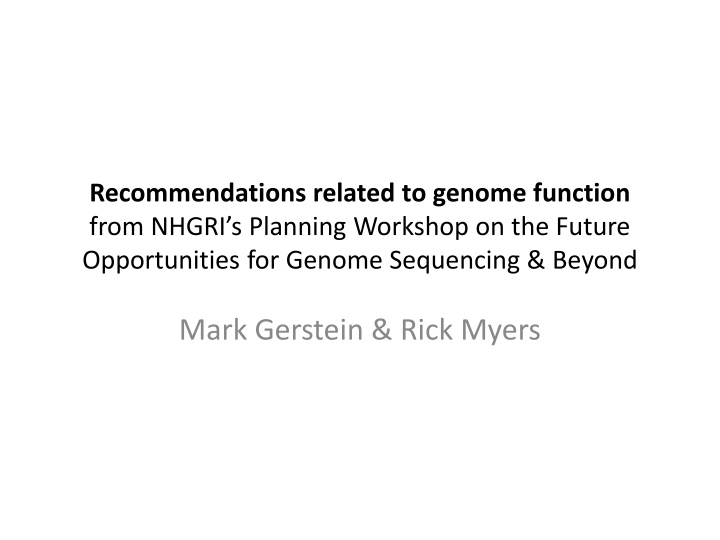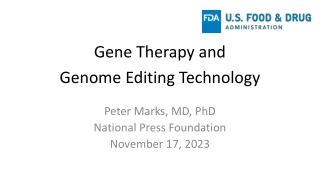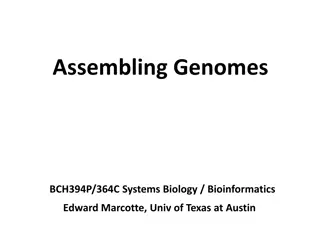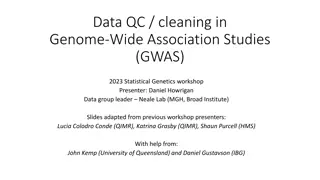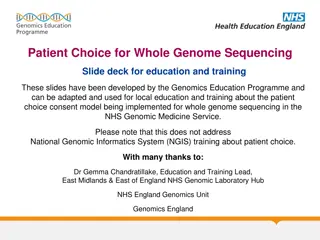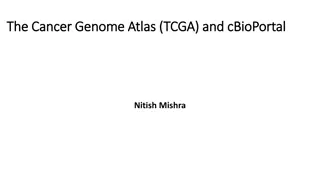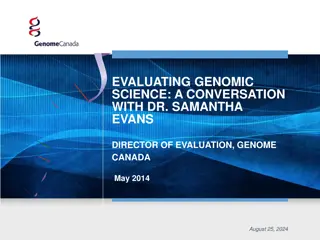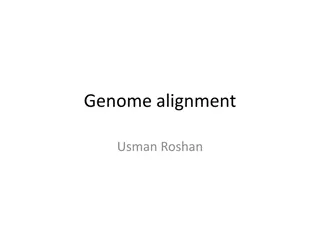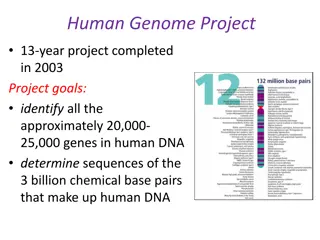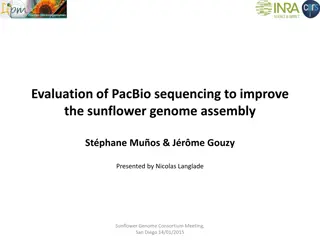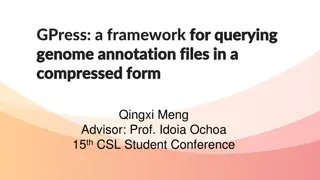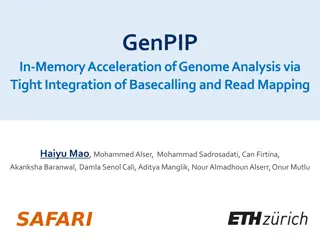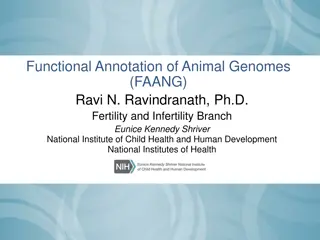Future Opportunities for Genome Function Recommendations
Workshop summaries and suggestions by Mark Gerstein and Rick Myers from the NHGRI's Planning Workshop on the critical need for functional annotation tools, development of biotechnological and computational resources, and systematic cataloging of non-coding elements.
Download Presentation

Please find below an Image/Link to download the presentation.
The content on the website is provided AS IS for your information and personal use only. It may not be sold, licensed, or shared on other websites without obtaining consent from the author.If you encounter any issues during the download, it is possible that the publisher has removed the file from their server.
You are allowed to download the files provided on this website for personal or commercial use, subject to the condition that they are used lawfully. All files are the property of their respective owners.
The content on the website is provided AS IS for your information and personal use only. It may not be sold, licensed, or shared on other websites without obtaining consent from the author.
E N D
Presentation Transcript
Recommendations related to genome function from NHGRI s Planning Workshop on the Future Opportunities for Genome Sequencing & Beyond Mark Gerstein & Rick Myers
Recommendations related to genome function Part 1: Workshop summary (Mark) Part 2: Our Additional Suggestions (Rick) Overall Key Message of both Parts Functional annotation is critical for NHGRI's mission Biotechnological & computational tools need to be developed for this Need a systematic catalog of non-coding elements & their interactions 2
Recommendations related to genome function Part 1: Workshop summary (Mark) Part 2: Our Additional Suggestions (Rick) Overall Key Message of both Parts Functional annotation is critical for NHGRI's mission Biotechnological & computational tools need to be developed for this Need a systematic catalog of non-coding elements & their interactions 3
Workshop last summer: Future Opportunities for Genome Sequencing & Beyond Goals: Discuss Qs & opportunities addressed using genomics studies, starting with genomic sequencing but also using other technologies Consider future NHGRI programs addressing these Slides and videos available at Genome.gov/27558042 4
Backdrop: A Future where NHGRI is only involved in minority of HG sequencing Human Genome Sequencing is a success story but what to do now? Most genome sequencing will be done outside of NHGRI NHGRI needs to position itself to positively influence the large amount of sequencing that will occur. Involving itself in partnerships Creating exportable technology, platforms & standards for interpreting the genome Focusing on things that scale 5
Sections within Workshop Genomic Architecture of Disease at Scale Exec Summary : Using genomic sequencing to determine variants underlying human disease & healthy traits, including both Mendelian & complex diseases, continues to be an important activity & will need to be addressed at scale. Integrating Genomic Variant Discovery with Function Improving our understanding of the impact of variants through functional genomics studies is critical to inform gene-disease relationships. Clinical Genomic Sequencing at Scale Translating genomics to medical practice will require a critical evaluation of the utility of sequencing & approaches to clinical implementation. Comparative & Evolutionary Genomics Thisis still needed to inform the prioritization and interpretation of genetic variants. 6 [Text adapted from workshop report genome.gov/27559219]
Sections within Workshop Genomic Architecture of Disease at Scale Exec Summary : Using genomic sequencing to determine variants underlying human disease & healthy traits, including both Mendelian & complex diseases, continues to be an important activity & will need to be addressed at scale. Integrating Genomic Variant Discovery with Function Improving our understanding of the impact of variants through functional genomics studies is critical to inform gene-disease relationships. Clinical Genomic Sequencing at Scale Translating genomics to medical practice will require a critical evaluation of the utility of sequencing & approaches to clinical implementation. Comparative & Evolutionary Genomics Thisis still needed to inform the prioritization and interpretation of genetic variants. 7 [Text adapted from workshop report genome.gov/27559219]
Integrating Genomic Variant Discovery with Function 1 Overview talk by J Ecker Discussion Group (~25): Mark Adams, Toby Bloom, Jim Broach, Carol Bult, Carlos Bustamante, Deborah Colantuoni, Joe Ecker, Elise Feingold, Kelly Frazer, Ross Hardison, Chanita Hughes-Halbert, Stephen Kingsmore, Jim Lupski, Gabor Marth, Debbie Nickerson, Mike Pazin, Len Pennacchio, Ulrike Peters, Aviv Regev, Jay Shendure, Mike Snyder, Simona Volpi, Peter Good Discussion summary by 2 (R Myers & M Gerstein) 8
Opportune time to study function on a large scale Huge number of variants available from many studies from NHGRI & beyond Functional characterization = connection between genomes & biology Recent development of new technologies CRISPR, large-scale epigenomics, single cell, etc. We need a foundational resource to integrate functional information on many discovered variants 9
What should the resource be? Different types of function At molecular/biochemical and cellular levels can be studied at scale & systematized Also, is closer to the variants At organismal level Not as easy to scale or to systematize NHGRI should find the sweet spot Problems that capitalize on the new technologies Lots of readout with modest investment Best models cells? mouse? model diseases? 10
Dichotomy of Directions Top-down: Develop catalogs of elements &/or all possible variants & then intersect them with variants found in disease studies ex: Shendure challenge talk Bottom-up: Start from a list of disease variants & characterize them functionally Both have merits 11
Multiple Approaches Approaches that look at large numbers of genes, variants, cell types, etc. in a standardized, high- throughput way In contrast: Deep disease/gene-specific studies Require domain experts & detailed assays, many of which cannot be scaled Not the province of NHGRI -- at least not on their own Important to have both & integrate them Build special informatics infrastructure to tie them together 12
Other considerations Scaling from the genome-scale assays to population-scale Success of eQTL & related projects Personal functional genomics, value in longitudinal studies Functional genomics is valuable beyond just variant characterization Use high-throughput sequencing to characterize cell types e.g., to develop cellular biomarkers ex: Regev challenge talk (Single-cell transcriptomics & Human Cell Atlas Project) 13
NHGRI synthesis of broader discussion (involving >100 people) of goals, opportunities & recommendations from the meeting
Rec #1: Defining the function of coding & noncoding sequences is foundational for genomics Develop & deploy assays reporting disease-relevant functions at the variant, gene & pathway levels 15 [Text adapted from workshop report genome.gov/27559219]
Rec #1: Defining the function of coding & noncoding sequences is foundational for genomics Develop & deploy assays reporting disease-relevant functions at the variant, gene & pathway levels Functions should be considered at different scales (e.g. molecular v. cellular) NHGRI should consider both function-first approaches and variant-first approaches. Computational methodsneed to be developed to predict the effect of coding and non-coding variants 16 [Text adapted from workshop report genome.gov/27559219]
Rec #2: Develop tools to manipulate genomic sequences at scale & experimentally characterize their impact Need develop new ways to measure function & determinecausality of stat. significant variants NHGRI should raise the technical challenge on how toscale up (to whole genome or whole population) the most important functional assays, while maintaining assay validity. Large scale assays need to be scaled from molecular to organ, organism, and clinical levels. Need to improve understanding on how proteins interact with the genome. NHGRI could help foster assays and models that allow us to test how drugs and other environmental agents interact with the genome. Personal genomics can be expanded to include personal functional genomics. 17 [Text adapted from workshop report genome.gov/27559219]
Rec #2: Develop tools to manipulate genomic sequences at scale & experimentally characterize their impact Need develop new ways to measure function & determinecausality of stat. significant variants NHGRI should raise the technical challenge on how toscale up (to whole genome or whole population) the most important functional assays, while maintaining assay validity. Large scale assays need to be scaled from molecular to organ, organism, and clinical levels. Need to improve understanding on how proteins interact with the genome. NHGRI could help foster assays and models that allow us to test how drugs & other environmental agents interact with the genome. Personal genomics can be expanded to include personal functional genomics. 18 [Text adapted from workshop report genome.gov/27559219]
Rec #3: Need to systematically catalog molecular components & their interactions Function should also be considered at the systems biology level The catalog of regulatory elements is not complete. Additional profiling of regulatory data needs to be done in key tissues and cell types. Functional genomics is valuable beyond characterization of variants. Sequencing can be used to characterize cell types. NHGRI should probably limit consideration to genetic effects, and should not further consider environmental or microbiome effects 19 [Text adapted from workshop report genome.gov/27559219]
Rec #3: Need to systematically catalog molecular components & their interactions Function should also be considered at the systems biology level The catalog of regulatory elements is not complete. Additional profiling of regulatory data needs to be done in key tissues and cell types. Functional genomics is valuable beyond characterization of variants. Sequencing can be used to characterize cell types. NHGRI should probably limit consideration to genetic effects, and should not further consider environmental or microbiome effects 20 [Text adapted from workshop report genome.gov/27559219]
Recommendations related to genome function Part 1: Workshop summary (Mark) Part 2: Our Additional Suggestions (Rick) Overall Key Message of both Parts Functional annotation is critical for NHGRI's mission Biotechnological & computational tools need to be developed for this Need a systematic catalog of non-coding elements & their interactions 21
Some important, crosscutting themes Large-scale genomics projects have helped to establish: Standardized experimental and analytical approaches Quality control metrics, resource development, economies of scale, and data sharing Generation of multiple data types and large studies that lead to meta- analysis and integration Small- and medium-scale genomics projects have advantages: More detailed knowledge and interest in specific biological problems Often geared towards determining mechanism, testing specific hypotheses Support wide range of researchers 22
Some important, crosscutting themes Large-scale genomics projects have helped to establish: Standardized experimental and analytical approaches Quality control metrics, resource development, economies of scale, and data sharing Generation of multiple data types and large studies that lead to meta- analysis and integration Small- and medium-scale genomics projects have advantages: More detailed knowledge and interest in specific biological problems Often geared towards determining mechanism, testing specific hypotheses Support wide range of researchers 23
Some important, crosscutting themes Knowledge of genome function is essential to understand human biology and genomic basis of disease 24
Some important, crosscutting themes Knowledge of genome function is essential to understand human biology and genomic basis of disease Evolutionary genomics is important Sequencing and alignment of primate and vertebrate genomes has helped identify >3 million conserved elements 25
Some important, crosscutting themes Knowledge of genome function is essential to understand human biology and genomic basis of disease Evolutionary genomics is important Sequencing and alignment of primate and vertebrate genomes has helped identify >3 million conserved elements We have learned an incredible amount by identifying human knock-outs (i.e. Mendelian diseases) and, to a smaller extent, dominant mutations 26
1: Additional suggestions for NHGRI Don t try to do everything in genomics: Partner with other NIH institutes 27
1: Additional suggestions for NHGRI Don t try to do everything in genomics: Partner with other NIH institutes Many very large-scale whole genome sequencing and functional genomics DNA projects are already being done -- and will continue to be done -- by other institutes Disease/organ-specific genomics 28
1: Additional suggestions for NHGRI Don t try to do everything in genomics: Partner with other NIH institutes Many very large-scale whole genome sequencing and functional genomics DNA projects are already being done -- and will continue to be done -- by other institutes Disease/organ-specific genomics But NHGRI can and should still play a major role in these studies (as follows) 29
2: Additional suggestions for NHGRI Continue to support development of new DNA sequencing technologies (and other high-throughput genomics/genetics approaches) 30
2: Additional suggestions for NHGRI Continue to support development of new DNA sequencing technologies (and other high-throughput genomics/genetics approaches) Support work that allows us to analyze every single base pair accurately, regardless of length or context of sequence variants e.g., missing sequence data may miss undiagnosed diseases 31
2: Additional suggestions for NHGRI Continue to support development of new DNA sequencing technologies (and other high-throughput genomics/genetics approaches) Support work that allows us to analyze every single base pair accurately, regardless of length or context of sequence variants e.g., missing sequence data may miss undiagnosed diseases Emphasize phenotypes 32
2: Additional suggestions for NHGRI Continue to support development of new DNA sequencing technologies (and other high-throughput genomics/genetics approaches) Support work that allows us to analyze every single base pair accurately, regardless of length or context of sequence variants e.g., missing sequence data may miss undiagnosed diseases Emphasize phenotypes Give much more support for advances in bioinformatics, computing and data analysis 33
2: Additional suggestions for NHGRI Continue to support development of new DNA sequencing technologies (and other high-throughput genomics/genetics approaches) Support work that allows us to analyze every single base pair accurately, regardless of length or context of sequence variants e.g., missing sequence data may miss undiagnosed diseases Emphasize phenotypes Give much more support for advances in bioinformatics, computing and data analysis Take a more systems biology approach Consider the effects of genetic variants in the larger context of the cell, the individual and the environment Perturbation approaches 34
3: Additional suggestions for NHGRI Put a much heavier emphasis on integration functional studies with evolutionary information This is not just measurement of conservation. Must integrate phylogeny, sequence similarity, human population genetics Continue to improve predictions of deleterious mutations (e.g., CADD, tolerance scores, FunSeq, etc.) 35
4: Additional suggestions for NHGRI Foster new and emerging methods for assessing function of base pairs in the genome Some production-type grants (but not too large) R01s to support creative technology development (perhaps partner with NIGMS) Very high-throughput genome editing Ultra-high throughput functional assays 36
5: Additional suggestions for NHGRI Be the lead in cataloguing different sequencing efforts 37
5: Additional suggestions for NHGRI Be the lead in cataloguing different sequencing efforts Create data sharing standards for more interoperability and collaboration 38
5: Additional suggestions for NHGRI Be the lead in cataloguing different sequencing efforts Create data sharing standards for more interoperability and collaboration Continue to expand beyond whole genome sequencing (e.g., very broad and deep functional genomics studies) 39
5: Additional suggestions for NHGRI Be the lead in cataloguing different sequencing efforts Create data sharing standards for more interoperability and collaboration Continue to expand beyond whole genome sequencing (e.g., very broad and deep functional genomics studies) Include large-scale efforts in epigenomics and metabolomics 40
5: Additional suggestions for NHGRI Be the lead in cataloguing different sequencing efforts Create data sharing standards for more interoperability and collaboration Continue to expand beyond whole genome sequencing (e.g., very broad and deep functional genomics studies) Include large-scale efforts in epigenomics and metabolomics Continue to lead in training genome scientists, clinical researchers, and support diversity 41
Why coordination would be good: #s of RNA-seq datasets from different consortia ENCODE: 588 REMC: 166 GTEx: 837 TCGA: 24,662 ICGC: 1,486 And many other functional genomic datasets are available from different consortia 42
For example: Establish a coordinated data integration and analysis hub 43
For example: Establish a coordinated data integration and analysis hub Integrate NHGRI-funded standardized data with large amount of other functional genomics data produced worldwide 44
For example: Establish a coordinated data integration and analysis hub Integrate NHGRI-funded standardized data with large amount of other functional genomics data produced worldwide Make functional genomics data into digestible annotation that can be interrelated with a variety of variants (common, rare, SVs, disease, etc.) 45
For example: Establish a coordinated data integration and analysis hub Integrate NHGRI-funded standardized data with large amount of other functional genomics data produced worldwide Make functional genomics data into digestible annotation that can be interrelated with a variety of variants (common, rare, SVs, disease, etc.) Develop standardized and exportable pipelines, QC metrics, and analysis approaches 46
For example: Establish a coordinated data integration and analysis hub Integrate NHGRI-funded standardized data with large amount of other functional genomics data produced worldwide Make functional genomics data into digestible annotation that can be interrelated with a variety of variants (common, rare, SVs, disease, etc.) Develop standardized and exportable pipelines, QC metrics, and analysis approaches Amazon model: build a shopping platform on a core (i.e., books) and then expand it outwards to everything 47
Recommendations related to genome function Part 1: Workshop summary (Mark) Part 2: Our Additional Suggestions (Rick) Overall Key Message of both Parts Functional annotation is critical for NHGRI's mission Biotechnological & computational tools need to be developed for this Need a systematic catalog of non-coding elements & their interactions 48
Recommendations related to genome function Part 1: Workshop summary (Mark) Part 2: Our Additional Suggestions (Rick) Overall Key Message of both Parts Functional annotation is critical for NHGRI's mission Biotechnological & computational tools need to be developed for this Need a systematic catalog of non-coding elements & their interactions 49
